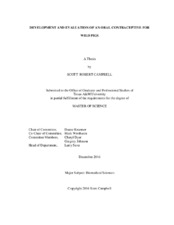| dc.description.abstract | Wild pigs are an invasive species widely distributed throughout Australia and the Americas. Wild pigs are carriers of over 30 zoonotic diseases and are a major source of crop destruction, with damages associated with pigs estimated at $1.5 billion annually in the U.S. alone. Current mitigation techniques such as trapping and shooting are rendered ineffective due to the high fecundity of pigs. Recent population models suggest that decreasing fertility would result in sustainably reduced populations of wild pigs. No fertility control product currently exists for wild pigs, although the combination of triptolide and 4-vinyclohexene diepoxide (VCD) in ContraPest®, a rat contraceptive product, shows considerable promise. The objective of this project was to evaluate fertility control bait (FCB) containing triptolide and VCD for its potential use in pigs. To evaluate the effects of this FCB on boar fertility, males (n=5) were provided active FCB twice daily for 15 days. Semen parameters were monitored before (D0) and after (D37, D45, and D60). Males that freely consumed the FCB, had significant decreases (p<0.05) in viability, morphology, and progressive motility were observed at D37 and D45, indicating decreased fertility. By D60, parameters began to trend upwards and histological evaluation of the testes showed normal spermatogenic activity suggesting a transient effect on spermatogenesis. Females were provided placebo (n=6) or active (n=5) FCB twice daily for 15 days. Thirty days after cessation of the treatment period (D50), ovaries were collected from all females. A significant decrease (p<0.05) in both ovarian mass and prevalence of preovulatory follicles in treated gilts suggested a decline in ovulation rate. Histological studies found significant reductions (p<0.05) in all immature follicular stages suggesting a prolonged decline in fertility. The results of these studies suggest the potential for developing an FCB, utilizing the combination of triptolide and VCD, to reduce the fecundity in both male and female wild pigs. | en |


